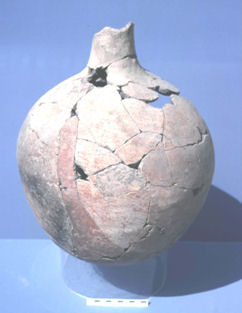Kissonerga-Mylouthkia, Cyprus 1976-1996
Edgar Peltenburg, 2009. https://doi.org/10.5284/1000051. How to cite using this DOI
Data copyright © Edgar Peltenburg unless otherwise stated
This work is licensed under the ADS Terms of Use and Access.
Primary contact
Archaeology Data Service
Dept. of Archaeology
The King's Manor
University of York
Y01 7EP
UK
Tel: +44 (0)1904 323954
Resource identifiers
- ADS Collection: 427
- DOI:https://doi.org/10.5284/1000051
- How to cite using this DOI
Overview
Investigations at Mylouthkia began in 1976 and continue intermittently until this day when tourist development threatens the site. There are four phases of work:
- First phase, 1976-1981: research: These uncovered many negative features of Periods 2. Preliminary results were published in Preliminary 1, 23-5; 2, 7, 18-20; 3, 28-31, 46-9; 4, 35, 54-7; Prehistory 1, 80-83; 2, 18-23; Betts 1979; Burleigh 1981; Elliott 1983; Peltenburg 1981.
- Second phase, 1989: rescue: The purpose of this work was to rescue material from discrete features that occurred some 50 m to the south of our earlier excavations in a zone where a hotel, the Queen's Bay, exists today. More Period 2 units were recovered, as well as the first Period 1 well.
- Third phase, 1994-1996: research and rescue: We returned to research mode in the third phase of investigations to test the theory that the original Chalcolithic ground surface may have survived in plot 58/496 and that we might find EChal structures contemporary with our recorded pits. In the event, traces of contemporary wooden structures and later, Period 3, stone-based structures were found here. Cleaning in adjacent plots 76-7led to the discovery and excavation of Period 1 features of the Cypro-PPNB period.
- Fourth phase, 2000-ongoing: rescue: A watching brief and selected excavation has led to much more information on Periods 1 and 2.
The intermittent and continuing investigations of Kissonerga-Mylouthkia, initiated by Prof. E. Peltenburg and latterly conducted by Dr. Paul Croft, have led to major contributions to two aspects of prehistory: the emergence of Neolithic society and the evolution of settlement choices on a Mediterranean island. In terms of the history of this Cypriot site, these advances concern Periods 1 and 2-3 respectively:
Periods of occupation at Kissonerga-Mylouthkia
| Period 1A | Cypro-EPPNB | c. 9,100 - 9,300 BP c. 8,200 - 8,600 Cal BC |
| Period 1B | Cypro-LPPNB | c. 8,000 - 8,200 BP c. 6,800 - 7,200 Cal BC |
| Hiatus | ||
| Period 2 | EChal | c. 4,600 - 4,800 BP c. 3,600 Cal BC |
| Period 3 | MChal | c. 4,600 - 4,700 BP c. 3,500 Cal BC |
| Hiatus | ||
| Late | Bronze Age-Medieval | c. 800 BC - AD 1600 |
Period 1 indicates a much earlier start for the Neolithic of Cyprus than hitherto imagined, one that necessitates re-consideration of current paradigms for the transition to the Neolithic way of life in the Near East. A series of radiocarbon dates shows occupation by farmers as early as c. 8300 cal BC. The material was discovered in what must be amongst the earliest wells in the world. Most of the material was analysed in institutions in the U.K. Mary Anne Murray (UCL) identified the seed material from these wells, Sue Colledge (UCL) was able to demonstrate its domestic status (see E. Peltenburg and A. Wasse eds. Neolithic Revolution. New perspectives on southwest Asia in light of recent discoveries on Cyprus: 49-60. Oxford, Oxbow Books), Carole McCartney (LARC) characterised the chipped stone assemblage showing affinities with the PPNA-B of the Levantine mainland, Bernard Gratuze (CNRS) identified the source of obsidian in central Anatolia, Sherry C. Fox (ASCS) identified the remains of a child of the 9th millennium cal BC in well 116, Eleni Asouti (UCL) analysed the wood charcoal, Janet Ridout-Sharpe the molluscan evidence, Paul Croft (LARC) the animal bones and Adam Jackson (Edinburgh) the many ground stone vessels, perhaps wasters deposited in the wells. The c. 8-9 m. deep wells have hand and footholds, and were excavated and described in this report by Paul Croft.
Period 2-3 evidence is particularly rewarding for a clearer understanding of long term settlement trajectories on the island. At least on two occasions in its prehistory, apparently well-established, sedentary communities virtually disappear from the archaeological record. This has raised questions about the long-term success of the colonists, island depopulation, and socio-economic strategies of insular societies. Mylouthkia 2 and 3 provide glimpses of behavioural modes during the 4th millennium cal BC transition from the Late Neolithic to the Chalcolithic.
The evidence adduced from a sequence of ephemeral structures and pits leading to circular mud buildings on stone footings suggests that the island was not abandoned after the Neolithic. The hypothesis put forward is that population growth in the Neolithic led to the founding of new settlements in woodland and that these were comprised of timber structures. With success came localised deforestation, erosion and the diminution of traces of those initial timber phases a process that has depleted the surviving archaeological record. The evidence is analysed by several of the scholars mentioned above, with the addition of Gordon Thomas (Edinburgh) for structures, Diane Bolger (Edinburgh) the pottery and Elizabeth Goring (National Museums of Scotland) the figurative repertoire.

This compilation consists of the following elements:
- Text of the final report which includes references to all relevant publications
- 51 Figures which follow the text in the final publication
- Pottery archive report: introduction and database. Diane Bolger
- Charcoal identification database. Eleni Asouti
- Molluscan database. Janet Ridout-Sharpe
- Palaeobotanical database. Mary Anne Murray
- Faunal database. Paul Croft
- Extended Register of Small finds
- Excavation images
- Small find selected images.






